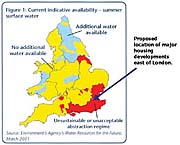Issue: 1/04
Water conservation has been one of the major research drivers over the past 10-15 years. It has affected w.c. design, drainage system sizing and vent design due to lower entrained airflows. It has impacted upon appliance design, from the development of the pressure-assisted flush and subsequent improvements to gravity operation, so ably discussed in PME (Nov. 2003), to the design of appliances such as washing machines and dishwashers. Water conservation has been promoted as "the right thing to do."



An additional problem is supply pipe ownership. The small diameter connection from the main across the homeowner's land is deemed the responsibility of the owner and not the water supplier. However, few owners feel the need to check and repair their supply pipes until a terminal leak develops.
While the Scottish water supply industry is separated from these actions by devolved legislation, the water leakage figures are equally concerning. More than a billion litres of drinking water are lost every day in Scotland through leaks, equivalent to 45% of supply. Scottish Water, in an echo of the Thames response, concluded that this was "a reflection on the poor state of Scotland's water mains."